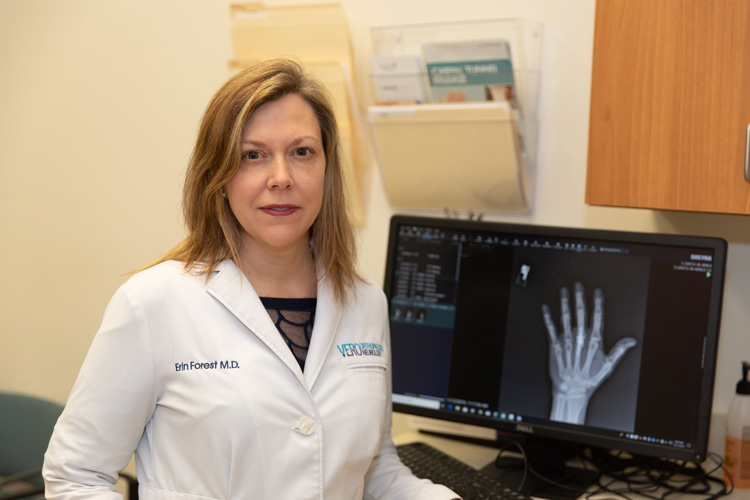
The odds are good you know someone who’s had a hip or knee joint replaced.
It’s far less likely you know someone with a high-tech elbow, wrist or finger joint replacement, and that’s not altogether surprising.
According to Harvard Medical School, “joint replacements in the hand are less common than surgery to replace a knee or hip joint, partly because the intricate bone structure and small size of the hand make the procedure more challenging.”
However, the challenge has been taken up by physicians like Dr. Erin Forest at Vero Orthopaedics & Neurology, and today hand, elbow, finger and wrist procedures are becoming increasingly commonplace.
According to Cleveland Clinic, if you have stiff and painful elbows, wrists or fingers, “joint replacement surgery may offer relief for you.”
Indeed, Dr. Peter Evans, an upper extremity surgeon at the Ohio Cleveland Clinic campus, goes so far as to call those procedures “life-changing.”
Evans continues by saying “joint replacement surgery is an effective way to eliminate joint pain, correct a deformity and improve limited motion” in the upper extremities, just as hip and knee replacements do in the lower extremities.
Forest, who is board-certified by the American Board of Orthopedic Surgery and fellowship-trained in hand and upper extremity surgery as well as microvascular surgery, has yet another upper extremity ace up her surgical sleeve.
Reconstruction.
“The most common joint reconstruction that we do,” Forest explains, “is not even a replacement; it’s actually a reconstruction of the thumb base. A lot of people will come in saying that they’ve got wrist pain or they’ve got thumb pain with pinching, grasping, opening jars or doors. And that’s very commonplace for us to do a reconstruction.
“There’s a lot of different ways to reconstruct that joint, but the most common way in a recent survey of all hand surgeons in the country is to do a joint arthroplasty with the patient’s own tissue. We borrow [the] tendon that bends the wrist and we use that to reconstruct the ligaments that hold the thumb in the right position. What’s left of the tendon goes into the space where there was bone on bone. So there’s no more bone rubbing on bone and we’ve got the patient’s own tissue, so it’s less likely to wear out over time. I’m doing probably two a week, on average” of that procedure.
How successful are these reconstructions?
Forest says it’s hard to tell – but for a positive reason. “It actually holds up so well,” she says, “it’s hard to get people back [into the office] to do the follow-ups” needed for outcome studies.
That said, whether a patient has replacement or reconstruction surgery, the recovery time isn’t short.
“Patients,” says Forest, “still have some therapy and some splints to deal with. Even though bony healing can take five or six weeks in the hand, for the soft tissue and ligament reconstruction procedures, we have to be careful with them for about three months. So it’s not necessarily something like a knee or hip where we have them up and walking the next day.”
Pausing briefly, she adds, “luckily people don’t put weight on their hands or their wrists right away and so we’ll have them in a splint and work with therapy and gradually work on their range of motion as things are healing up.”
Most commonly doctors recommend joint replacement for patients who have osteoarthritis, rheumatoid arthritis or significant deformity and dysfunction. Harvard Medical says more than 20 million Americans – most of them women – have osteoarthritis and 2 million more, 70 percent of whom are women, have rheumatoid arthritis.
For all those people it is good news that safe and effective treatments for their conditions have steadily evolved since they were first introduced in 1959.
Indeed, the National Institutes of Health admits that those early endeavors in small joint arthroplasty “were not particularly auspicious, resulting from poor implant design, ineffective [implant] materials and an incomplete understanding of small joint mechanics.”
Today, NIH says, “advances in small joint arthroplasty have revolutionized the care of patients with trauma, arthritis, stiffness and instability” in upper extremity joints.
For instance, instead of the all-steel prosthetics of the late 1950s, today’s versions are more likely to be made of silicone, polyethylene, titanium or pyrocarbon, which are less likely to degrade or loosen over time while providing improved range of motion and greater stability.
If pain in your hands, wrist or elbow is keeping you from living the life you want to lead, talk to your primary care physician or an orthopedic specialist. Medicare and most private insurers will likely help pick up the cost.
Dr. Erin Forest is with Vero Orthopaedics & Neurology at 1155 35th Lane, Suite 100 in Vero Beach. The phone number is 772-569-2330.



